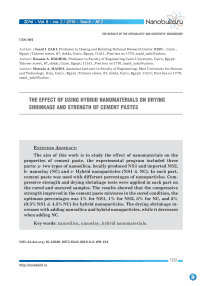The effect of using hybrid nanomaterials on drying shrinkage and strength of cement pastes
Автор: Zaki Saaid I., Hossam A. hodhod, Mostafa A. mahdi
Журнал: Нанотехнологии в строительстве: научный интернет-журнал @nanobuild
Статья в выпуске: 2 т.8, 2016 года.
Бесплатный доступ
The aim of this work is to study the effect of nanomaterials on the properties of cement paste, the experimental program included three parts: a- two types of nanosilica, locally produced NS1 and imported NS2, b- nanoclay (NC) and c- Hybrid nanoparticles (NS1 & NC). In each part, cement paste was used with different percentages of nanoparticles. Compressive strength and drying shrinkage tests were applied in each part on the cured and uncured samples. The results showed that the compressive strength improved in the cement paste mixtures in the cured condition, the optimum percentages was 1% for NS1, 1% for NS2, 5% for NC, and 5% (0.5%NS1 & 4.5%NC) for hybrid nanoparticles. The drying shrinkage increases with adding nanosilica and hybrid nanoparticles, while it decreases when adding NC.
Nanosilica, nanoclay, hybrid nanomaterials
Короткий адрес: https://sciup.org/14266070
IDR: 14266070 | DOI: 10.15828/2075-8545-2016-8-2-109-134
Список литературы The effect of using hybrid nanomaterials on drying shrinkage and strength of cement pastes
- Mahdi MA. The Effect of Using Nano Materials on the Properties of Cement Paste and Mortar. M.Sc Thesis on Structural Department, Faculty of Engineering, Cairo University, Egypt, September 2015.
- Mohamed A.M. Influence of Nano Materials on Flexural Behavior and Compressive Strength of Concrete. HBRC Journal, November 2014.
- Sobhy I. Effect of Using Nano-Silica Particles on the Properties of Different Concrete Mixes. MSc. Thesis, Civil Department, Faculty of Engineering, Helwan University, Egypt 2012.
- Morsy M.S., Alsayed S.H., Aqel M. Hybrid Effect of Carbon Nanotube and Nano-Clay on Physico-Mechanical Properties of Cement Mortar. Construction and Building Materials, 25 (2011), PP (145-149).
- Yang H. Strength and Shrinkage Property of Nano Silica Powder Concrete. Department of Civil Engineering, Shandong Jiaotong University, Jinan, Shandong, 250023, China, 2nd International Conference on Electronic & Mechanical Engineering and Information Technology (EMEIT-2012).
- Sadrmomtazi A., Fasihi A. Influence of Polypropylene Fibers on the Performance of Nano-Sio2-Incorporated Mortar. Iranian Journal of Science & Technology, Transaction B: Engineering, Vol. 34, No. B4, PP (385-395) Printed in The Islamic Republic of Iran, 2010 Shiraz University.
- Tobön J.I, Restrepo O.J, Payä J. Comparative Analysis of Performance of Portland Cement Blended with Nanosilica and Silica Fume. Dyna, May 12th, 2010, 163, PP (37-46).
- Belkowitz J.S., Armentrout D. An Investigation of Nano Silica in the Cement Hydration Process Concrete Sustainability Conference. National Ready Mixed Concrete Association, 2012, PP (1-15).
- Sadrmomtazi A., Fasihi A., Balalaei F., Haghi A.K. Investigation of Mechanical and Physical Properties of Mortars Containing Silica Fume and Nano-SiO2. The 3rd International Conference on Concrete and Development, Tehran, Iran, PP (11531161), April 2009.
- Senff L., Labrincha JOA., Ferreira V.M., Hotza D., Repette W.L. Effect of NanoSilica on Rheology and Fresh Properties of Cement Pastes and Mortars. Construction and Building Materials 23, 8 February 2009, PP (2487-2491).
- Hakamy A., Shaikh F.U.A., Low I.M. Characteristics of Hemp Fabric Reinforced Nanoclay-Cement Nanocomposites. Cement & Concrete Composites, 50 (2014), PP (27-35).
- M.S. Morsy, S.H. Sayed Al., Aqel M. Effect of Nano-clay on Mechanical Properties and Microstructure of Ordinary Portland Cement Mortar. International Journal of Civil & Environmental Engineering IJCEE-IJENS (2010) Vol: 10 No: 01.
- ES Specification 2421. Determination of Standard Water Cement Ratio for Cement Pastes.
- ECP 203. Drying Shrinkage of Cement Mortar Containing Portland cement. Egyptian Code for Design and Construction of Concrete Structures, Tests Guide, part 1 PP (62-67), HBRC, Cairo, Egypt, 2003.
- ASTM C 157-04. Test Method for Length Change of Hardened Hydraulic Cement Mortar and Concrete. ASTM inter, 2004.
- Zaki. S.I. Assessment of the Durability of Nano Silica/Fly Ash Cement Pastes Exposed to Normal and Aggressive Curing Conditions. Seventh International Conference On Nanotechnology in Construction (NTC 2015), Sharm El-Sheikh, Egypt, March 2015.
- Zaki S.I., Sobhy I. The Use of Activated Nano Clay to Develop the Compressive Strength and Microstructure of High Performance Concrete. CTU Conference, Concrete in the Low Carbon Era, the University of Dundee, UK, 9-11 July. 2012.
- Zaki S.I., Ragab K.S., Rashad A.M. The Use of Nano SiO2 to Develop the Water Permeability and Microstructure of High Performance Concrete». International conference on Nano Technology for Green and Sustainable Construction 14-17, Cairo, Egypt, March 2010.
- Zaki S.I., Ragab K.S. How Nano Technology Can Change Concrete Industry. 1st International Conference On Sustainable Built Environment Infrastructures in Developing Countries, ISSN 2170-0095, Oran, Algeria, 12-14 October 2009, vol. 1, PP (407-414).
- Zaki Saaid I. Assessment of the durability of nanosilica/Fly ash cement pastes exposed to normal and aggressive curing conditions. Nanotehnologii v stroitel’stve = Nanotechnologies in Construction. 2015, Vol. 7, no. 3, pp. 78-99. -DOI: dx.doi. org/10.15828/2075-8545-2015-7-3-78-99.
- Zaki Saaid I. Application of ultra cellulose fiber for the enhancement of the durability and shrinkage of cement pastes exposed to normal and aggressive curing conditions. Nanotehnologii v stroitel’stve = Nanotechnologies in Construction. 2015, Vol. 7, no. 4, pp. 121-142 DOI: 10.15828/2075-8545-2015-7-4-121-142


